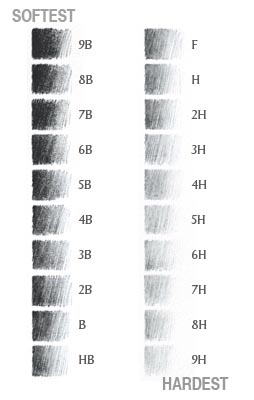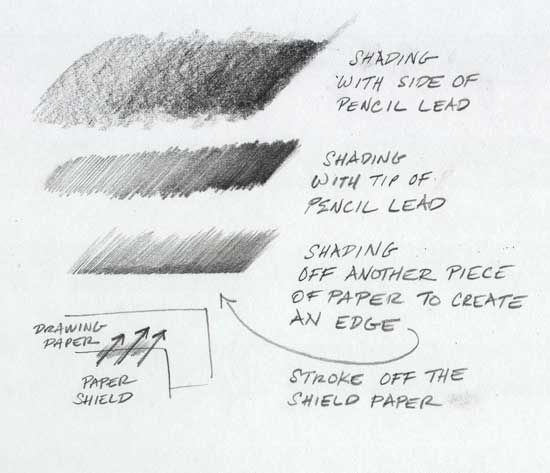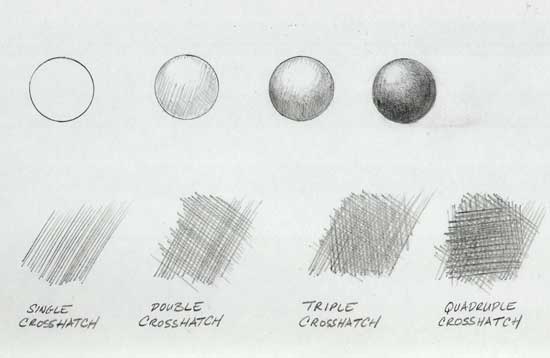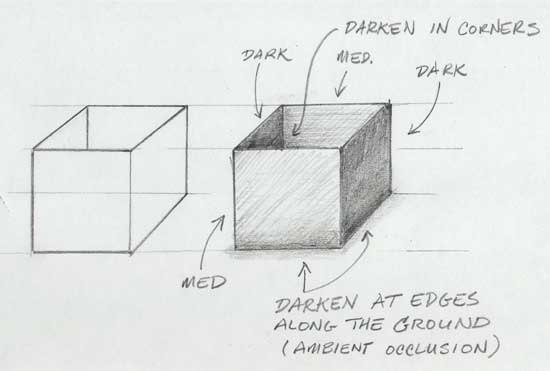There’s a lot to cover, so let’s get started!
1. Make sure there’s a direct light source.
Before I started on the drawing for this tutorial, the first thing I did was set up a lamp pointing at my still life from just a few feet away. I also turned off all the other lights in the room to increase contrast and clarify each shadow.
It’s extremely important to make good lighting for yourself when you’re drawing indoors. If you don’t have that strong directional light, you won’t be able to see the shadows and highlights and your drawing will most likely turn out gray and visually flat.
2. Use a viewfinder to set up your composition.
 This is the
best way I’ve found to start a drawing, and it’s pretty easy too. All
you need to do is cut a rectangle out of a piece of cardboard (like a
shoebox lid) and use it to visually crop your subject.
This is the
best way I’ve found to start a drawing, and it’s pretty easy too. All
you need to do is cut a rectangle out of a piece of cardboard (like a
shoebox lid) and use it to visually crop your subject.Store-bought viewfinders work too. I’m just cheap.
Move the viewfinder around until you’ve found the best composition possible and tape it in place. Then draw the same size of rectangle on your paper.
When you look through the viewfinder, everything within the frame is what you’ll draw, and you can ignore the rest. Not only will it improve your compositions, but it will also help with the next few steps in the drawing process.
3. Start drawing objects that intersect the border.
Always begin drawings along the edges first, before you do anything else. This will “anchor” your drawing in place and keep you from running out of space later on.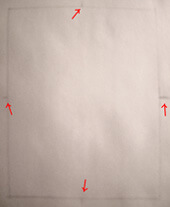 To
make sure I’m starting in the right place, I usually make little marks
halfway along each edge of my drawing, and then in the same place on the
cardboard viewfinder.
To
make sure I’m starting in the right place, I usually make little marks
halfway along each edge of my drawing, and then in the same place on the
cardboard viewfinder.You can’t see those marks on the viewfinder above, but on the paper to the left I’ve put red arrows to show where they are.
These marks give me smaller distances to measure between when I’m staring at my blank paper trying to figure out where along the edges I should begin.
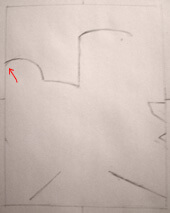 For
instance, the first line I made was the curved line on the left side of
the rectangle. I looked through the viewfinder and took note of the
spot where the outline of the orange crossed the edge of the border. It
was just slightly below the halfway point between one of my marks and
the top.
For
instance, the first line I made was the curved line on the left side of
the rectangle. I looked through the viewfinder and took note of the
spot where the outline of the orange crossed the edge of the border. It
was just slightly below the halfway point between one of my marks and
the top.If I hadn’t had that mark, it would have been a lot harder to decide exactly where to draw the line.
(This idea is similar to using a grid, except there aren’t any lines running across the picture.)
4. Check line angles with your pencil.
 I
wanted to make sure that the two diagonal lines at the bottom of my
drawing were correct, so I matched my pencil to the angles that I saw in
the still life, and then moved my hand (while keeping the pencil at the
same angle) in front of my paper and made sure the angles that I drew
lined up.
I
wanted to make sure that the two diagonal lines at the bottom of my
drawing were correct, so I matched my pencil to the angles that I saw in
the still life, and then moved my hand (while keeping the pencil at the
same angle) in front of my paper and made sure the angles that I drew
lined up.This is a great way to get correct perspective lines, edges of buildings, or anything, really. No matter what I’m drawing this technique often comes in handy. Just make sure that you don’t subconsciously change the angle of your pencil to match your drawing.
5. Work around each edge and then move inward.
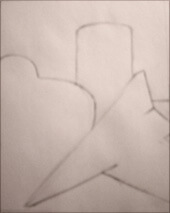 Once
my drawing was “anchored,” I worked my way towards the center,
extending all of my original lines until they connected with each other.
Once
my drawing was “anchored,” I worked my way towards the center,
extending all of my original lines until they connected with each other.While you do this, you’ll generally want to keep moving all around the paper so that whole drawing progresses evenly. At this point in the drawing you should only be putting down the main outlines—no details or shading!
Draw lightly as well. When you get to tip #9 you’ll see why it’s a good idea.
6. Draw the negative space around the objects.
 This tip I learned from Drawing on the Right Side of the Brain
This tip I learned from Drawing on the Right Side of the BrainWhat you do is, instead of trying to draw a bowl or fruit, draw the negative shapes between objects instead. Does that make sense?
The problem with just thinking “draw that orange,” is that your mind will bring up non-visual ideas about oranges instead of letting you focus on the specific shapes in front of you.
7. Close one eye to flatten out the image.
I always squint with one eye when I draw, and I’m sure many of you do as well. This helps because it eliminates depth perception and makes the subject you’re drawing appear flat. Be consistent in which eye you use, though; if you switch eyes you’ll see the objects move slightly, which can mess you up.8. Look back and forth as often as possible.
 Spending
too much time looking at your paper—instead of your subject—won’t work,
and it’s easy to understand why. If your eyes are always on your paper,
you won’t ever be seeing what you’re supposed to be drawing.
Spending
too much time looking at your paper—instead of your subject—won’t work,
and it’s easy to understand why. If your eyes are always on your paper,
you won’t ever be seeing what you’re supposed to be drawing.So when you draw or paint, flick your eyes back and forth and never let them rest for too long in one place.
With practice, your eyes will do this naturally, but it’s important if you’re just starting out to do it purposefully at first to build up the habit.
9. Erase when you see something wrong.
Don’t just leave your mistakes there—fix them! If you can see a problem early on, your finished drawing will have it too. By then you won’t want to go all the way back and change everything, so get it right before you’re too far in.What a lot of people don’t understand is that the most important partof any drawing is the initial line drawing. So always erase if you need to, because once you’ve got a good line drawing, you’re home free.
10. Shade from darkest to lightest.

Once the line drawing is done, start filling in the darkest shadows first. Remember to look for areas of reflected light on the shadow sides of objects. Almost everything reflects light at least a little bit, and leaving those areas lighter will make your drawings much more three-dimensional. After your dark shadows are done, begin to work on the lighter tones all the way up to white.
11. Include a full range of values.
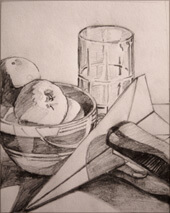 At
this point I was nearing the end of my drawing, so I wanted to make
sure that the darkest shadow area was pure black, and the brightest
highlight was white.
At
this point I was nearing the end of my drawing, so I wanted to make
sure that the darkest shadow area was pure black, and the brightest
highlight was white.Having a full range of values in a drawing looks more natural, since it’s how we see in real life and it’s is easy enough to do by just adding more darks or using an eraser to pull out more highlights.
And even if there don’t seem to be pure black or pure white areas in real life, lie just a little bit and add them in anyway; your final drawing will look better.
12. Take a break before finishing.
When the drawing is almost finished, I usually take a breather, walk around, and then come back to finish it.After being away for a while, you’ll be able see if there are mistakes or places that should be completed but somehow got overlooked. Fix those, and at the same time use your eraser to pick out the brightest highlights in your drawing.

And there’s the finished piece. I hope you enjoyed this tutorial; it was fun for me to just use pencils for a change, instead of my normal oil paints.
When it comes to drawing it’s really never too late to improve, and you’ll get more out of it than just nice pencil work. I know that I learned to paint fairly easily simply because I already had a strong foundation in drawing.



